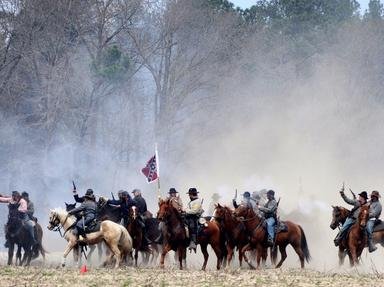Quiz Answer Key and Fun Facts
1. We'll start with one of the first battles of the war: Big Bethel?
2. Now we'll go to western Virginia and another early battle of the war: Philippi?
3. Enough of the small battles for now; can you tell me the loser of the First Battle of Bull Run (Manassas)?
4. Another smaller battle: Ball's Bluff?
5. Now we move into 1862; can you name the loser at the battle of Port Republic?
6. Another somewhat smaller battle: Mechanicsville (Beaver Dam Creek)?
7. Gaines' Mill?
8. Malvern Hill?
9. Now we shall get away from the Peninsula and focus on the operations in northern Virginia during August 1862. Can you tell me who lost the Second Battle of Bull Run (2nd Manassas)?
10. After 2nd Bull Run, Lee took his army north into Maryland. Along the way he dispatched Jackson to take the town of Harpers Ferry, Virginia. Can you name the loser there?
11. After Harpers Ferry, Lee quickly recalled all of the parts of his army to a position behind Antietam Creek, near Sharpsburg, Maryland. Can you name the strategic loser of the battle of Antietam (Sharpsburg)?
12. After retreating from Maryland, Lee went into winter quarters near Fredericksburg, Virginia. The Union Army of the Potomac attacked him there on December 13, 1862. What Union commander lost this battle?
13. After spending the winter facing each other across the Rappahannock River, both armies resumed campaigning in late April. The Army of the Potomac moved around the Confederate right flank to attack at a place called Chancellorsville. Who lost here?
14. There was one division still left at Fredericksburg during the battle of Chancellorsville. This division was attacked on May 3, 1863, by the Union VI Corps. This engagement was known as the Battle of Second Fredericksburg, but who lost it?
15. After a drawn cavalry battle at Brandy Station, the Confederates moved north on an invasion into Pennsylvania. This invasion culminated in the battle of Gettysburg, the bloodiest of the war. Which general lost here?
16. After retreating to Virginia, Lee's army recuperated and waiting for a Union pursuit. Lieutenant General A.P. Hill, getting impatient, launched a premature attack on elements of the Union II Corps on October 14, 1863, at Bristoe Station. Who lost this battle?
17. In a search for proper winter quarters, the Union army forced two crossings of the Rappahannock River in Early November. What commander lost the battle of Rappahannock Station?
18. During the spring of 1864, Ulysses S. Grant came east to take command of the Union army personally. He started his Overland Campaign to take Richmond with the battle of the Wilderness. Who strategically lost this battle?
19. Grant and Lee's next fight took place at Spotsylvania. At this long battle (thirteen days), there were many momentum changes. Who strategically lost THIS battle?
20. By 1864, the Union cavalry finally could stand up for itself. However, this did not always ensure victory. Who lost the battle of Yellow Tavern?
21. In another long battle (this one 13 days as well), Grant's army again fought Lee's. Who lost the battle of Cold Harbor?
22. After entering into siege warfare at Petersburg, both sides languished in trenches. The stalemate was broken on July 30, 1864, when a massive crater blew into the Confederate lines. Who lost the battle of the Crater?
23. Lieutenant General Jubal S. Early was given Stonewall Jackson's old corps and ordered to distract Union troops in the Shenandoah Valley. After campaigning for a few months, he attacked the Union army under Major General Philip Sheridan at Cedar Creek. Who lost this battle?
24. Becoming desperate early in 1865, Robert E. Lee gambled on breaking up the Union siege with an attack on Fort Stedman. Who lost this battle?
25. The Siege of Petersburg finally was broken at the Battle of Five Forks. What general (who expertly spent the day at a shad bake) lost this battle?
Source: Author
TheJay
This quiz was reviewed by FunTrivia editor
bloomsby before going online.
Any errors found in FunTrivia content are routinely corrected through our feedback system.
